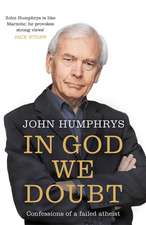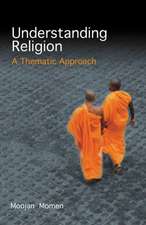Religious Diversity in Southeast Asia and the Pacific: National Case Studies
Autor Gary D. Bouma, Rodney Ling, Douglas Pratten Limba Engleză Paperback – 26 noi 2014
| Toate formatele și edițiile | Preț | Express |
|---|---|---|
| Paperback (1) | 640.24 lei 6-8 săpt. | |
| SPRINGER NETHERLANDS – 26 noi 2014 | 640.24 lei 6-8 săpt. | |
| Hardback (1) | 646.43 lei 6-8 săpt. | |
| SPRINGER NETHERLANDS – 23 dec 2009 | 646.43 lei 6-8 săpt. |
Preț: 640.24 lei
Preț vechi: 753.22 lei
-15% Nou
Puncte Express: 960
Preț estimativ în valută:
122.53€ • 126.58$ • 101.97£
122.53€ • 126.58$ • 101.97£
Carte tipărită la comandă
Livrare economică 25 martie-08 aprilie
Preluare comenzi: 021 569.72.76
Specificații
ISBN-13: 9789400791053
ISBN-10: 9400791054
Pagini: 292
Ilustrații: XX, 270 p.
Dimensiuni: 155 x 235 x 15 mm
Greutate: 0.41 kg
Ediția:2010
Editura: SPRINGER NETHERLANDS
Colecția Springer
Locul publicării:Dordrecht, Netherlands
ISBN-10: 9400791054
Pagini: 292
Ilustrații: XX, 270 p.
Dimensiuni: 155 x 235 x 15 mm
Greutate: 0.41 kg
Ediția:2010
Editura: SPRINGER NETHERLANDS
Colecția Springer
Locul publicării:Dordrecht, Netherlands
Public țintă
ResearchCuprins
The Antipodes and Japan.- Australia.- Japan.- New Zealand.- Island Nations of South East Asia.- Brunei Darussalam.- Timor Leste.- Indonesia.- Malaysia.- Papua New Guinea.- Philippines.- Singapore.- Sri Lanka.- Thailand.- Pacific Island Nations.- Cook Islands.- Fiji.- French Polynesia.- Kiribati.- Marshall Islands.- Federated States of Micronesia.- Nauru.- New Caledonia.- Northern Marianas.- Palau.- Samoa.- Solomon Islands.- Tonga.- Tuvalu.- Vanuatu.- Integrative Chapters.- Minority Religious Groups and the State.- Religious Competition.- Women and Religious Diversity.- Regional Interfaith Dialogue.
Notă biografică
Gary D Bouma is Emeritus Professor of Sociology and UNESCO Chair in Interreligious and Intercultural Relations – Asia Pacific at Monash University in Victoria, Australia, and Chair of Board of Directors for The Parliament of the World’s Religions 2009. He is Associate Priest in the Anglican Parish of St John’s East Malvern, Melbourne.
Rod Ling is a Research Assistant in the Institute for Social Change, University of Manchester and was until recently UNESCO Postdoctoral Fellow in the School of Political and Social Inquiry, Monash University.
Douglas Pratt is Associate Professor in the Department of Philosophy and Religious Studies at the University of Waikato, New Zealand. He is also the New Zealand Associate of the UNESCO Chair in Intercultural and Interreligious Relations – Asia Pacific and an Adjunct Senior Research Fellow of the School of Political and Social Inquiry, Monash University.
Rod Ling is a Research Assistant in the Institute for Social Change, University of Manchester and was until recently UNESCO Postdoctoral Fellow in the School of Political and Social Inquiry, Monash University.
Douglas Pratt is Associate Professor in the Department of Philosophy and Religious Studies at the University of Waikato, New Zealand. He is also the New Zealand Associate of the UNESCO Chair in Intercultural and Interreligious Relations – Asia Pacific and an Adjunct Senior Research Fellow of the School of Political and Social Inquiry, Monash University.
Textul de pe ultima copertă
Religious diversity is now a social fact in most countries of the world. While reports of the impact of religious diversity on Europe and North America are reasonably well-known, the ways in which Southeast Asia and Asia Pacific are religiously diverse and the ways this diversity has been managed are not. This book addresses this lack of information about one of the largest and most diverse regions of the world. It describes the religious diversity of 27 nations, as large and complex as Indonesia and as small as Tuvalu, outlining the current issues and the basic policy approaches to religious diversity. Southeast Asia and the Pacific Islands are portrayed as a living laboratory of various religious blends, with a wide variance of histories and many different approaches to managing religious diversity. While interesting in their own right, a study of these nations provides a wealth of case studies of diversity management – most of them stories of success and inclusion.
Caracteristici
Describes the critical global issue of religious diversity and how it is managed in Southeast Asia and Asia Pacific Provides an easily searchable, country-by-country description of the religious constituency and its history Is the result of a project of the UNESCO Chair in Interreligious and Intercultural Relations for Asia Pacific














